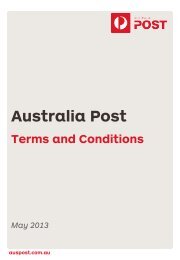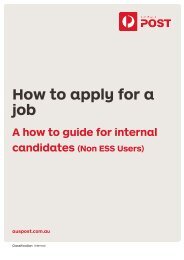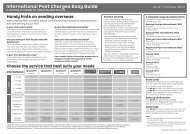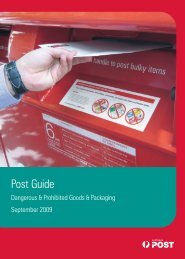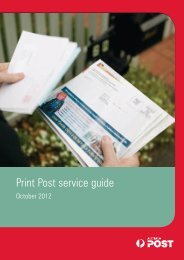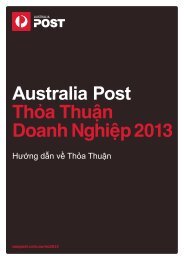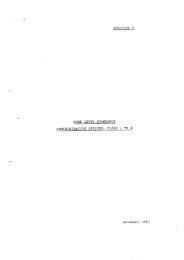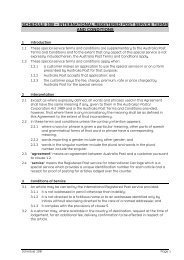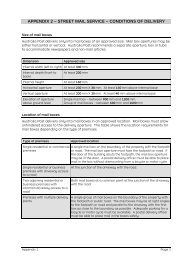2009-10 Annual Report - Australia Post
2009-10 Annual Report - Australia Post
2009-10 Annual Report - Australia Post
Create successful ePaper yourself
Turn your PDF publications into a flip-book with our unique Google optimized e-Paper software.
notes to And ForminG PArt oF the FinAnCiAl rePort For the year ended 30 June 20<strong>10</strong><br />
Management has identified the following critical accounting policies<br />
for which significant judgements, estimates and assumptions are<br />
made. actual results may differ from these estimates under different<br />
assumptions and conditions and may materially affect financial results<br />
or the financial position reported in future periods.<br />
Further details of the nature of these assumptions and conditions may<br />
be found in the relevant notes to the financial statements.<br />
investment property<br />
the group obtains independent third party valuations of its investment<br />
property portfolio annually. the basis of these valuations is outlined<br />
in note 15 and includes certain significant assumptions.<br />
impairment of jointly controlled entities, goodwill and intangibles<br />
with indefinite useful lives<br />
the group determines whether jointly controlled entities, goodwill and<br />
intangibles with indefinite useful lives are impaired at least on an annual<br />
basis. this requires an estimation of the recoverable amount of jointly<br />
controlled entities and cash generating units, to which the goodwill and<br />
intangibles with indefinite useful lives are allocated. recoverable amount<br />
is assessed using a value in use discounted cashflow methodology. the<br />
assumptions used in the estimation of recoverable amount of goodwill<br />
and intangibles with indefinite useful lives are discussed in note 16.<br />
make good provisions<br />
Management have made assumptions in arriving at their best<br />
estimate of the likely costs to “make good” premises which are currently<br />
occupied under operating lease. such estimates involve management<br />
forecasting the average restoration cost per square metre and are<br />
dependent on the nature of the premises occupied. the provision<br />
recognised is periodically reviewed and updated based on the facts<br />
and circumstances available at the time. changes to the estimated<br />
future costs are recognised in the balance sheet by adjusting both<br />
the expense or asset (if applicable) and provision. the related carrying<br />
amounts are disclosed in note 20.<br />
employee benefits<br />
Various assumptions are required when determining the group’s<br />
superannuation, separation and redundancy, long service leave, annual<br />
leave and workers’ compensation obligations. note 12 describes the key<br />
assumptions used in calculating the group’s superannuation obligation,<br />
whilst note 1(ee) details the basis and certain significant assumptions<br />
for the other employee benefits.<br />
unearned postage revenue<br />
the group makes allowance for the assessed amount of revenue from<br />
postage sales as at balance date in respect of which service has not<br />
yet been provided. actuarial valuations are obtained every three years<br />
and the provision is reassessed every six months based on factors<br />
provided by the group’s external actuaries.<br />
(ii) significant accounting judgements<br />
investment property classification<br />
the group has determined that those properties classified as investment<br />
properties are primarily held to earn rentals or for capital appreciation.<br />
Where a property is also used for internal use, the group has determined<br />
whether this is an insignificant portion of total floor space and, if so,<br />
classified the property as investment property.<br />
operating lease commitments – group as lessor<br />
the group has commercial property leases on its investment property<br />
portfolio. the group has determined that it retains all the significant risks<br />
and rewards of ownership of these properties and has thus classified<br />
the leases as operating leases.<br />
50<br />
AustrAliA <strong>Post</strong> AnnuAl rePort <strong>2009</strong>–<strong>10</strong> | Financial and statutory reports<br />
(e) Business combinations<br />
Subsequent to 1 January <strong>2009</strong><br />
Business combinations are accounted for using the acquisition<br />
method. the consideration transferred in a business combination shall<br />
be measured at fair value, which shall be calculated as the sum of the<br />
acquisition-date fair values of the assets transferred by the acquirer, the<br />
liabilities incurred by the acquirer to former owners of the acquiree and<br />
the equity issued by the acquirer and the amount of any non-controlling<br />
interest in the acquiree. For each business combination, the acquirer<br />
measures the non-controlling interest in the acquiree either at fair value<br />
or at the proportionate share of the acquiree’s identifiable net assets.<br />
acquisition-related costs are expensed as incurred.<br />
When the group acquires a business, it assesses the financial assets<br />
and liabilities assumed for appropriate classification and designation<br />
in accordance with the contractual terms, economic conditions, the<br />
group’s operating or accounting policies and other pertinent conditions<br />
as at the acquisition date. this includes the separation of embedded<br />
derivatives in host contracts by the acquiree.<br />
if the business combination is achieved in stages, the acquisition date<br />
fair value of the acquirer’s previously held equity interest in the acquiree<br />
is measured at fair value as at the acquisition date through profit or loss.<br />
any contingent consideration to be transferred by the acquirer will be<br />
recognised at fair value at the acquisition date. subsequent changes<br />
to the fair value of the contingent consideration, which is deemed to<br />
be an asset or liability, will be recognised in accordance with aasB 139:<br />
Financial Instruments: Recognition and Measurement, either in profit or<br />
loss or in other comprehensive income. if the contingent consideration is<br />
classified as equity, it shall not be remeasured.<br />
Prior to 1 January <strong>2009</strong><br />
Business combinations were accounted for using the purchase method.<br />
transaction costs directly attributable to the acquisition formed part of<br />
the acquisition costs. the non-controlling interest was measured at the<br />
proportionate share of the acquiree’s identifiable net assets.<br />
(f) revenue recognition<br />
revenue is recognised and measured at the fair value of the<br />
consideration received or receivable to the extent it is probable that the<br />
economic benefits will flow to the group and the revenue can be reliably<br />
measured. the following specific recognition criteria must also be met<br />
before revenue is recognised:<br />
(i) sale of goods and services<br />
revenue is recognised when the significant risks and rewards of<br />
ownership of the goods have passed to the buyer and the costs incurred<br />
or to be incurred in respect of the transaction can be measured reliably.<br />
risks and rewards of ownership are considered passed to the buyer at<br />
the time of delivery of the goods to the customer. recognition is at point<br />
of sale in the case of postage items and provision of agency services,<br />
point of lodgement in the case of bulk mail and when control of goods<br />
has passed to the buyer in the case of retail products. allowance is<br />
made for the assessed amount of revenue from postage sales as at<br />
balance date in respect of which service had not yet been provided.<br />
(ii) interest revenue<br />
revenue is recognised as interest accrues using the effective interest<br />
method. this is a method of calculating the amortised cost of a financial<br />
asset and allocating the interest income over the relevant period using<br />
the effective interest rate, which is the rate that exactly discounts<br />
estimated future cash receipts through the expected life of the financial<br />
asset to the net carrying amount of the financial asset.




